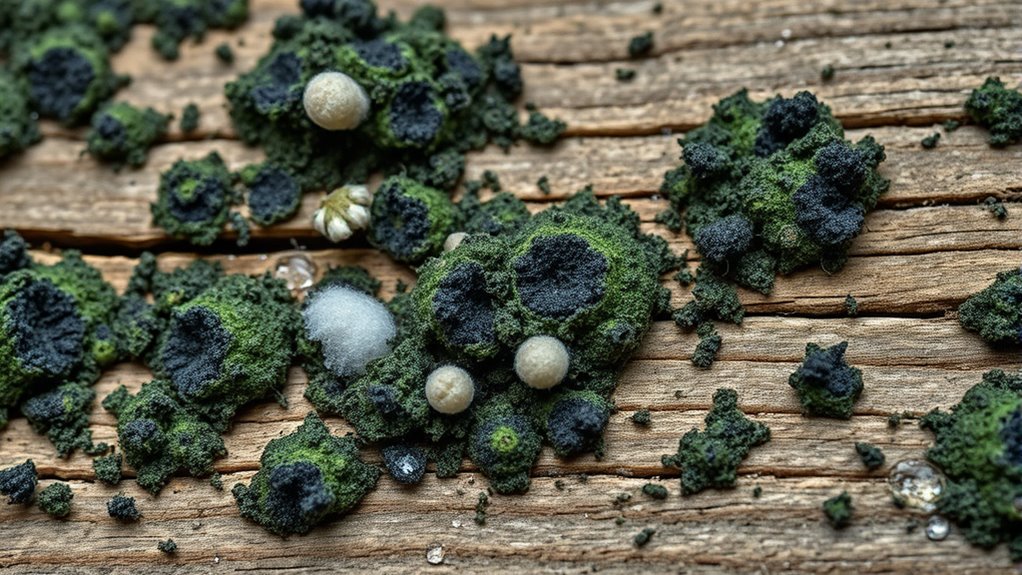To measure mold and mycotoxin presence, testing typically includes air sampling to detect airborne spores and surface analysis to identify mold on various surfaces. Air tests reveal what’s in the air you breathe, while surface samples show visible or hidden mold. Both methods work together to give a complete picture of contamination levels and toxin risks. If you want to understand more about how these tests help protect your health, keep exploring the details.
Key Takeaways
- Mold testing involves air sampling to detect airborne spores and surface analysis to identify mold presence on surfaces.
- Air sampling measures spores suspended in the air, revealing inhalation risks even when no visible mold is present.
- Surface testing samples mold directly from surfaces, confirming contamination and identifying specific mold types and mycotoxins.
- Combining air and surface testing provides a comprehensive assessment of mold and mycotoxin contamination.
- Certified professionals perform standardized testing and lab analysis to determine mold species, concentrations, and associated health risks.

Mold and mycotoxins can pose serious health risks, especially if you’re exposed to them in your home or workplace. To accurately assess the presence and extent of mold contamination, testing is essential. Two primary methods used in mold detection are air sampling and surface analysis. Air sampling involves collecting airborne spores in your environment, providing insight into what you’re breathing in. This method captures spores suspended in the air over a specified period, which can help determine if mold spores are present at levels that might harm your health. It’s particularly useful in spaces where visible mold isn’t apparent but there may still be airborne contamination. Air sampling results can guide you in deciding whether professional remediation is necessary and help evaluate the effectiveness of cleaning efforts afterward.
Surface analysis, on the other hand, focuses on collecting samples directly from surfaces that appear moldy or suspect. This method involves swabbing, tape lifts, or bulk sampling of materials like drywall, carpets, or wood. Surface analysis allows for direct identification of mold growth and can reveal hidden or embedded mold that isn’t visible to the naked eye. It’s especially valuable when you need to confirm mold presence in specific areas or determine the type of mold involved. By analyzing surface samples in a lab, professionals can identify the species of mold and detect mycotoxins that might be present. This is vital because some molds produce toxins that can have severe health effects even if the visible mold growth is minimal.
Both air sampling and surface analysis are complementary techniques; using them together provides a thorough picture of mold contamination. While air sampling can reveal whether mold spores are circulating in your environment, surface analysis pinpoints the actual sources of mold growth. When conducting these tests, it’s best to work with certified professionals who follow standardized procedures to guarantee accurate results. Once samples are collected, they’re sent to a lab for detailed analysis, which can take a few days. The results will specify whether mold or mycotoxins are present, their concentrations, and often, the specific mold species involved. Armed with this information, you can make informed decisions about remediation, reducing health risks and preventing future mold growth. Overall, proper testing using air sampling and surface analysis is the key to understanding and managing mold and mycotoxin exposure in your environment.
Frequently Asked Questions
How Often Should Mold Testing Be Conducted in Homes?
You should test for mold at least once a year, especially during seasonal changes when moisture levels fluctuate. After heavy rains, leaks, or flooding, conduct testing immediately to catch hidden mold growth. Maintaining good moisture control is key to preventing mold, but regular testing helps you identify any unseen issues early. Stay vigilant, and increase testing frequency if you notice musty odors or visible mold, ensuring a healthy home environment.
Are All Mycotoxins Detectable With Current Testing Methods?
Not all mycotoxins are detectable with current testing methods due to detection limitations and testing accuracy challenges. You might find that some tests miss certain mycotoxins, especially in low concentrations or when mold isn’t actively growing. To improve detection, it’s vital to use thorough testing methods and work with professionals who understand these limitations. This way, you can better assess potential mold risks in your home.
Can Testing Identify the Source of Mold Growth Accurately?
Yes, testing can identify the source of mold growth accurately by focusing on source identification. You need to use precise testing methods like air sampling, surface swabs, and moisture assessments to pinpoint the exact location of mold. These techniques improve testing accuracy, helping you determine where mold originates. By accurately identifying the source, you can address the problem effectively and prevent future mold issues in your space.
What Are the Health Risks of Low-Level Mycotoxin Exposure?
Imagine living in a home with low-level mycotoxin exposure; over time, this can lead to health issues like immune suppression. Long-term exposure may cause fatigue, headaches, or respiratory problems, even if symptoms seem minor initially. You might not notice immediate effects, but your immune system weakens gradually, making you more vulnerable to illnesses. It is crucial to address mold issues early to prevent these subtle yet serious health risks.
How Reliable Are DIY Mold Testing Kits?
DIY mold testing kits can be somewhat reliable, but their accuracy varies. You should know that DIY accuracy is often limited because these kits may not detect all mold types or mycotoxins effectively. Testing limitations include false positives or negatives, so consider them as preliminary tools rather than definitive solutions. For thorough results, it’s best to consult a professional mold inspector who uses lab testing methods.
Conclusion
Testing mold and mycotoxins is like shining a flashlight in a dark room—you uncover hidden dangers and gain peace of mind. By understanding what these tests measure, you can better protect your health and home. Remember, catching mold early is like catching a small leak before it becomes a flood. Stay vigilant, get tested when needed, and keep your environment safe—because knowing is the first step toward a healthier, mold-free life.









